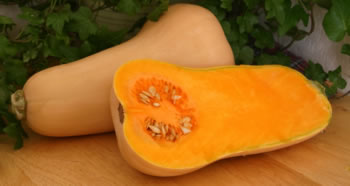Butternut

Last night I worked late. On the way home, I grabbed a butternut squash; the squash bin looks great this time of year and though squash is a mystery to me, Cooks has a nice-looking recipe for butternut squash risotto as a main course.
Yum.
Some things to remember for next time:
- "Serves four as a main course" is optimistic when you're eating at a fashionable 9:30. Of course, there were only to of us, but there wasn't nearly as much left over as I expected.
- Cooks discovered that, instead of adding broth in half-cup increments and stirring continuously for a half hour, you can dump three of the four cups of broth at once, stir occasionally, and everything still works.
- The recipe uses 1.5 cup of wine, chiefly to get enough acid to balance the squash's sweetness. That's nice, though it sure makes a dent in the bottle.
- The squash wasn't as sweet as I'd expected. That's not a bad thing entirely, but perhaps I might brown it more aggressively next time.
- Cooks suggests that you sauté the seeds and fibers, dump those into the broth, and then strain the broth. Easy enough. One reason I made this is that I had some nice home-made chicken double-stock that was nearing its sell-by date. It's hard to disentangle the good stock from the added zap of the sautéed seeds.
Why am I telling you this? Partly, because Cook's is a fine thing to read, and a terrific insight into scientific thinking for everyone. Partly, because it's fun to talk about food, and there's a lot of food in the blogosphere right now.
And partly because I've been thinking about notes as a medium for conversation -- with yourself, with your future self, and with your colleagues. Maybe markets aren't conversations, but notes certainly are!
So I'm writing this for myself, later this winter when I'm looking for something hot and hearty to cook because the heating bills are so high that the thermostat is in the ice zone. And I'm writing this for the cooks and farmers and critics who always email me interesting ideas when I write about food, or (better yet) write those interesting ideas in their own weblogs. And maybe I'm writing this to get the whole question straight in my mind -- especially whether a meatless entrée excuses 1T of butter per serving.
You've got to write stuff down -- and you've got to be able to find it again. In other words, you need two places to write: one that's always with you and one that's permanent, searchable, and smart. The one that's always with you can be as simple as a Hipster or a Moleskine: it just has to be there. The permanent journal can be a carefully indexed desk journal or it can be Tinderbox: Tinderbox gives you agents and instant search and spatial hypertext and all, but it's not quite as physical and concrete as a desk journal. (XML will last, but you can't feel its permanence the way you can feel good leather and Amalfi paper)